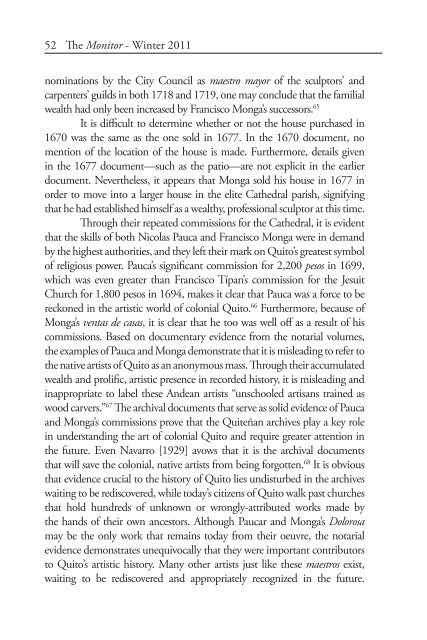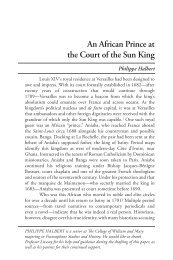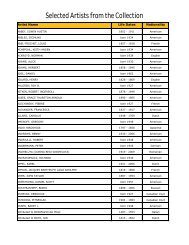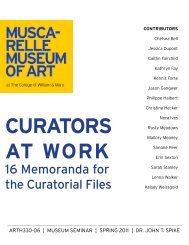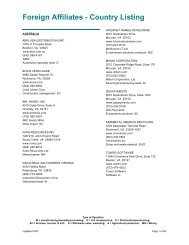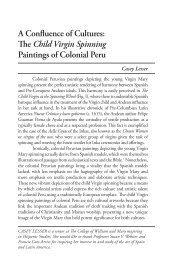Andean Artists in Colonial Quito: - College of William and Mary
Andean Artists in Colonial Quito: - College of William and Mary
Andean Artists in Colonial Quito: - College of William and Mary
You also want an ePaper? Increase the reach of your titles
YUMPU automatically turns print PDFs into web optimized ePapers that Google loves.
52 The Monitor - W<strong>in</strong>ter 2011<br />
nom<strong>in</strong>ations by the City Council as maestro mayor <strong>of</strong> the sculptors’ <strong>and</strong><br />
carpenters’ guilds <strong>in</strong> both 1718 <strong>and</strong> 1719, one may conclude that the familial<br />
wealth had only been <strong>in</strong>creased by Francisco Monga’s successors. 65<br />
It is difficult to determ<strong>in</strong>e whether or not the house purchased <strong>in</strong><br />
1670 was the same as the one sold <strong>in</strong> 1677. In the 1670 document, no<br />
mention <strong>of</strong> the location <strong>of</strong> the house is made. Furthermore, details given<br />
<strong>in</strong> the 1677 document—such as the patio—are not explicit <strong>in</strong> the earlier<br />
document. Nevertheless, it appears that Monga sold his house <strong>in</strong> 1677 <strong>in</strong><br />
order to move <strong>in</strong>to a larger house <strong>in</strong> the elite Cathedral parish, signify<strong>in</strong>g<br />
that he had established himself as a wealthy, pr<strong>of</strong>essional sculptor at this time.<br />
Through their repeated commissions for the Cathedral, it is evident<br />
that the skills <strong>of</strong> both Nicolas Pauca <strong>and</strong> Francisco Monga were <strong>in</strong> dem<strong>and</strong><br />
by the highest authorities, <strong>and</strong> they left their mark on <strong>Quito</strong>’s greatest symbol<br />
<strong>of</strong> religious power. Pauca’s significant commission for 2,200 pesos <strong>in</strong> 1699,<br />
which was even greater than Francisco Típan’s commission for the Jesuit<br />
Church for 1,800 pesos <strong>in</strong> 1694, makes it clear that Pauca was a force to be<br />
reckoned <strong>in</strong> the artistic world <strong>of</strong> colonial <strong>Quito</strong>. 66 Furthermore, because <strong>of</strong><br />
Monga’s ventas de casas, it is clear that he too was well <strong>of</strong>f as a result <strong>of</strong> his<br />
commissions. Based on documentary evidence from the notarial volumes,<br />
the examples <strong>of</strong> Pauca <strong>and</strong> Monga demonstrate that it is mislead<strong>in</strong>g to refer to<br />
the native artists <strong>of</strong> <strong>Quito</strong> as an anonymous mass. Through their accumulated<br />
wealth <strong>and</strong> prolific, artistic presence <strong>in</strong> recorded history, it is mislead<strong>in</strong>g <strong>and</strong><br />
<strong>in</strong>appropriate to label these <strong>Andean</strong> artists “unschooled artisans tra<strong>in</strong>ed as<br />
wood carvers.” 67 The archival documents that serve as solid evidence <strong>of</strong> Pauca<br />
<strong>and</strong> Monga’s commissions prove that the Quiteñan archives play a key role<br />
<strong>in</strong> underst<strong>and</strong><strong>in</strong>g the art <strong>of</strong> colonial <strong>Quito</strong> <strong>and</strong> require greater attention <strong>in</strong><br />
the future. Even Navarro [1929] avows that it is the archival documents<br />
that will save the colonial, native artists from be<strong>in</strong>g forgotten. 68 It is obvious<br />
that evidence crucial to the history <strong>of</strong> <strong>Quito</strong> lies undisturbed <strong>in</strong> the archives<br />
wait<strong>in</strong>g to be rediscovered, while today’s citizens <strong>of</strong> <strong>Quito</strong> walk past churches<br />
that hold hundreds <strong>of</strong> unknown or wrongly-attributed works made by<br />
the h<strong>and</strong>s <strong>of</strong> their own ancestors. Although Paucar <strong>and</strong> Monga’s Dolorosa<br />
may be the only work that rema<strong>in</strong>s today from their oeuvre, the notarial<br />
evidence demonstrates unequivocally that they were important contributors<br />
to <strong>Quito</strong>’s artistic history. Many other artists just like these maestros exist,<br />
wait<strong>in</strong>g to be rediscovered <strong>and</strong> appropriately recognized <strong>in</strong> the future.


